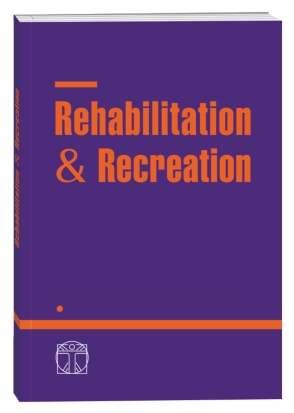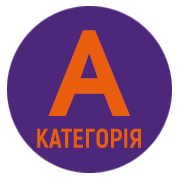DYNAMICS OF THE LEVEL OF MOBILE ABILITY OF PATIENTS AFTER LAPAROSCOPIC CHOLECYSTECTOMY IN THE LONG-TERM PERIOD OF REHABILITATION
DOI:
https://doi.org/10.32782/2522-1795.2022.13.3Keywords:
motor capacity, cholecystectomy, rehabilitation, movement functionality.Abstract
Goal. To determine the dynamics of the level of motor performance of patients after laparoscopic cholecystectomy in the long-term rehabilitation period. Materials and methods. 79 patients after laparoscopic cholecystectomy aged 45 to 59 years, who were operated on from 1 to 6 months. The patients underwent rehabilitation in the sanatorium-resort complex Morshinkurort in the rehabilitation department "Lavanda". Methods: randomization by simple random drawing, measurement of median value (Me), upper and lower quartiles (25%; 75%). The Mann-Whit-ney U-test was used to compare independent samples, dependent samples – Wilcoxon's T-test. Functional Movement Screen (FMS) – testing used to assess movement functionality. Group A patients received physical therapy using general developmental exercises. In group B, individual rehabilitation programs were formed on the basis of detected functional impairments based on the results of motor performance testing. The results. There was no statistical difference between groups A and B before the implementation of the rehabilitation intervention. Both groups showed the lowest results in test 1 "Deep squat” which indicates the weakness of the back extensor muscles, the asymmetry of the strength of the back muscles and the abdominal press, a decrease in the amplitude of movements in the hip, knee, ankle-foot joints, and imbalance. Low scores in Test 2 – "Step over the barrier", indicating low coordination and interaction between the hips and trunk during walking, reduced dynamic balance of the lower limbs. There were low results of exercise 3 – "Linear lunge", which was used to assess the stability and mobility of the hips, ankle-foot joints, the flexibility of the quadriceps muscle, and the stability of the trunk, clavicles, and knees. The primary assessment of patients according to test Nº 7 – "Circular stability" indicates reduced coordination of movements (balance), weakness and asymmetry of the postural muscles of the back, abdominal press during combined movements of the upper and lower limbs. After the physical therapy, the motor performance of both groups was re-evaluated. A statistical difference was found in the comparison of the results of both groups in tests Nº 1, 2, 3, 7 in group B. Conclusions. Functional training contributes to the restoration of balance functions, coordination qualities, functionality of trunk and limb muscles after cholecystectomy during the long-term rehabilitation stage.
References
Arora D., Kaushik R., Kaur R. et al. Postcholecystectomy syndrome: A new look at an old problem. J Minimal Access Sur. 2018. № 14. P. 202-207. DOI: 10.4103/jmas.JMAS_92_17.
Jensen S.W., Gelbel J. Postcholecystectomy Syndrome Clinical Presentation. Medscape. 2018. URL: http://www.emedicine.medscape. com/article/192761-overview (date access 7.09.2021).
Koishibayeva L., Turgunov Ye., Teleuov M. et al. Comparing of Quality of Life in cholecystitis patients before and after cholecystectomy. Abstractbok. Kirurgveckan: JKPG Jönköping. Sweden, 2017. 287 р.
Comerford M.J., Sport E.X. Screening to Identify Injury and Performance Risk: movement control testing – the missing piece of the puzzle. Medicine. 2006. July. Р. 21-26.
International Classification of Functioning, Disability and Health (ICF), Geneva, Switzerland: World Health. 2001. URL: https://physrehab. org.ua/wp-content/uploads/docs/5210-preklad_ mkf_dorosla_v_docx.pdf.
Голод Н. Метод оцінки рухової дієздатності. Науково-практичний журнал «Art of Medicine». 2017. № 4(4). С. 60-68. URL: https:// art-of-medicine.ifnmu.edu.ua/index.php/aom/ article/view/216 (дата звернення 29 Лис 2022).
Golod N., Churpiy I., Yaniv O., et al. The Influence of the Application of Mineral Water on the Functional State of the Liver of Patients after Laparoscopic Cholecystektomia in the Long Period of Rehabilitation. Acta Balneologica. 2022. № 1(167). P. 29-33. DOI: 10.36740/ ABAL202201106.
Alieksieienko N., Babov K., Hushcha S. et al. New Nyniv mineral water spring in Morschyn resort. Drohobych: Kolo. 2012, 148 p. (in Ukrainian)
Golod N., Buhaienko T., Imber V., Kara S., Zastavna O., Prysiazhniuk O., Kravchuk M. The Results of the Examination of Patients After Laparoscopic Cholecystectomy in the Acute Period of Rehabilitation Using the International Classification of Functioning Acta Balneologica. 2022. № 3 (278). P. 222-229. DOI: 10.36740/ ABAL202203104
Prodinger B., Stucki G., Coenen M., Tennant A. The measurement of functioning using the International Classification of Functioning, Disability and Health: comparing qualifier ratings with existing health status instruments. Disabil. Rehabil. 2019. № 41(5). P. 541-548.
Hertsyk A. The creation of programs of physical rehabilitation/therapy in musculoskeletal disorders. Slobozans’kij naukovo-sportivnij visnik. 2016. № 5(55). P. 22–7.
Romanyshyn N. Fundamentals of the construction of a rehabilitation diagnosis in clinical practice by a physical rehab. Pedagog. psychol. med.- biol. probl. phys. train. sport. 2012. № 1. P. 94-96.
Alaparthi G.K., Augustine A.J., Anand R., Mahale A. Comparison of Diaphragmatic Breathing Exercise, Volume and Flow Incentive Spirometry, on Diaphragm Excursion and Pulmonary Function in Patients Undergoing Laparoscopic Surgery: A Randomized Controlled Trial. Minim Invasive Surg. 2016;2016:1967532. DOI: 10.1155/2016/1967532. Epub 2016 Jul 21. PMID: 27525116; PMCID: PMC4972934.
Downloads
Published
How to Cite
Issue
Section
License

This work is licensed under a Creative Commons Attribution-NonCommercial-NoDerivatives 4.0 International License.












